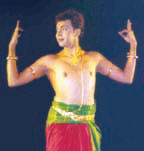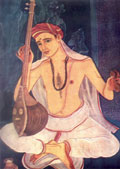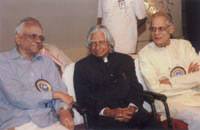NEWS & NOTES

Nritya Sangam
A rare treat in Jamshedpur -SUNIL KOTHARI
Organised by the Central Sangeet Natak Akademi, Nritya Sangam, a festival of classical dances of India was held at Jamshedpur recently in collaboration with the Department of Tourism, Government of Jharkhand at the Tata Auditorium, XLRI, featuring leading dancers of the country, and showcasing the important Indian dance forms.
"This Nritya Sangam is aimed at as a rare treat to the rasika-s, students and teachers of Jamshedpur… as a helpful signpost in their own journey into the world of dance," said Jayant Kastuar, who fifty years ago started his career as a child artist in Kathak at Jamshedpur. He acknowledged the support of the new state of Jharkhand. Their enthusiasm for organising such a festival was commendable.
The aim was to sensitise the audience, including dancers from nearby Seraikella village. The dancers and guru-s from the Seraikella project of Sangeet Natak Akademi attended the festival along with local artists. The presence of a cross section of leading artists and officers of government agencies was a hopeful sign of the interest these bodies were evincing.
COVER STORY

On the path to Tyagaraja
Tyagaraja was born 221 years ago this month. Numerous aradhana-s are held not only in Tiruvaiyaru, home of his samadhi, but all over the world, the great saint composer’s devotees leaving no stone unturned in paying homage to his memory. Some of these celebrations continuing into his birth month rival the traditional winter homage in number and variety of programmes as much as the devotion and dedication with which they are conducted. In this issue we publish accounts of a few of them across the globe.
Biographies of the bard-sage abound, and some of them are of high quality. William J. Jackson, Head of the Department of Religious Studies, Indiana University-Purdue University, Indianapolis, U.S.A., who first came to south India in 1970, has not only written books on Tyagaraja but also translated his songs, including the opera Nauka Charitram. Serendipity recently brought him into contact with Sruti, resulting in the following first person account of his journey on the path to Tyagaraja.
SPECIAL FEATURE

Semponnarkoil S.R.D. Vaidyanathan
A master of the nagaswara -V. Karpagalakshmi
Semponnarkoil S.R.D. Vaidyanathan is the recipient of two noteworthy awards this year. He was recently honoured with the Golden Jubilee Award of the Narada Gana Sabha which was presented to him by A.P.J. Abdul Kalam. The prestigious Central Sangeet Natak Akademi Award was presented to him by the President of India, Pratibha Devisingh Patil, in February in New Delhi.
S.R.D. Vaidyanathan is a fifth generation nagaswara vidwan from an illustrious family of artists from the village of Semponnarkoil near Mayiladuturai in Tamil Nadu. He traces his ancestry to Pallavi Vaidyanatha Pillai and his son V. Ramaswamy Pillai, whose music was recorded for HMV ninety years ago, a first for a nagaswara vidwan. He was accompanied by Ammachatiram Kannusamy Pillai — the guru of Mudicondan Venkatarama Iyer — on the tavil.
Ramaswamy Pillai and his wife Kuttiammal had two sons S.R. Govindaswamy Pillai and S.R. Dakshinamoorthy Pillai. Both of them learnt vocal music from Koorainadu Sambamoorthy Iyer and the nagaswara from their father. They initially accompanied him in his concerts and later started performing as a duo. They were the adheena vidwans or court musicians of Dharmapuram, Tiruvavaduturai and Tiruppanandal, played in the zameens of Sivagiri, Sethur, Neykarampatti, Singampatti and the samasthanam-s of Mysore, Vijayanagar, and Pithapuram, earning wide acclaim. They were known for their rakti melam and sarvalaghu.
HERITAGE

Sangeeta Sthalam-s
Narada Gana Sabha
A model sabha - SRIRAM.V ( With inputs from R.K. Tagat and R. Krishnaswami )
Narada Gana Sabha began its golden jubilee celebrations on 1st February this year with an inauguration by Dr. A.P.J. Abdul Kalam, former President of India. Post-Independence, it has been one of the handful of sabha-s of Madras city to have survived and emerged successful. The organisation is a byword for efficiency, its auditorium one of the best in the city, and the quality of programmes offered consistent. Today the office-bearers, of whom R. Krishnaswami, the Secretary is the best known face, smile quietly in satisfaction, but the road was not always smooth.
The 1950s saw a spurt in the growth of Madras city. Areas to the south of old Mylapore were developing, with CIT Colony the first, followed by Raja Annamalai Puram. More houses were coming up on Mowbrays (T.T.K.) Road and Cathedral Road. It was a time when new sabha-s were also being founded. One such was the Gopalapuram Sangeeta Sabha which operated from a school in that area but it folded up in 1956. The erstwhile members of this outfit began looking out for a new cultural body with which to affiliate themselves.


